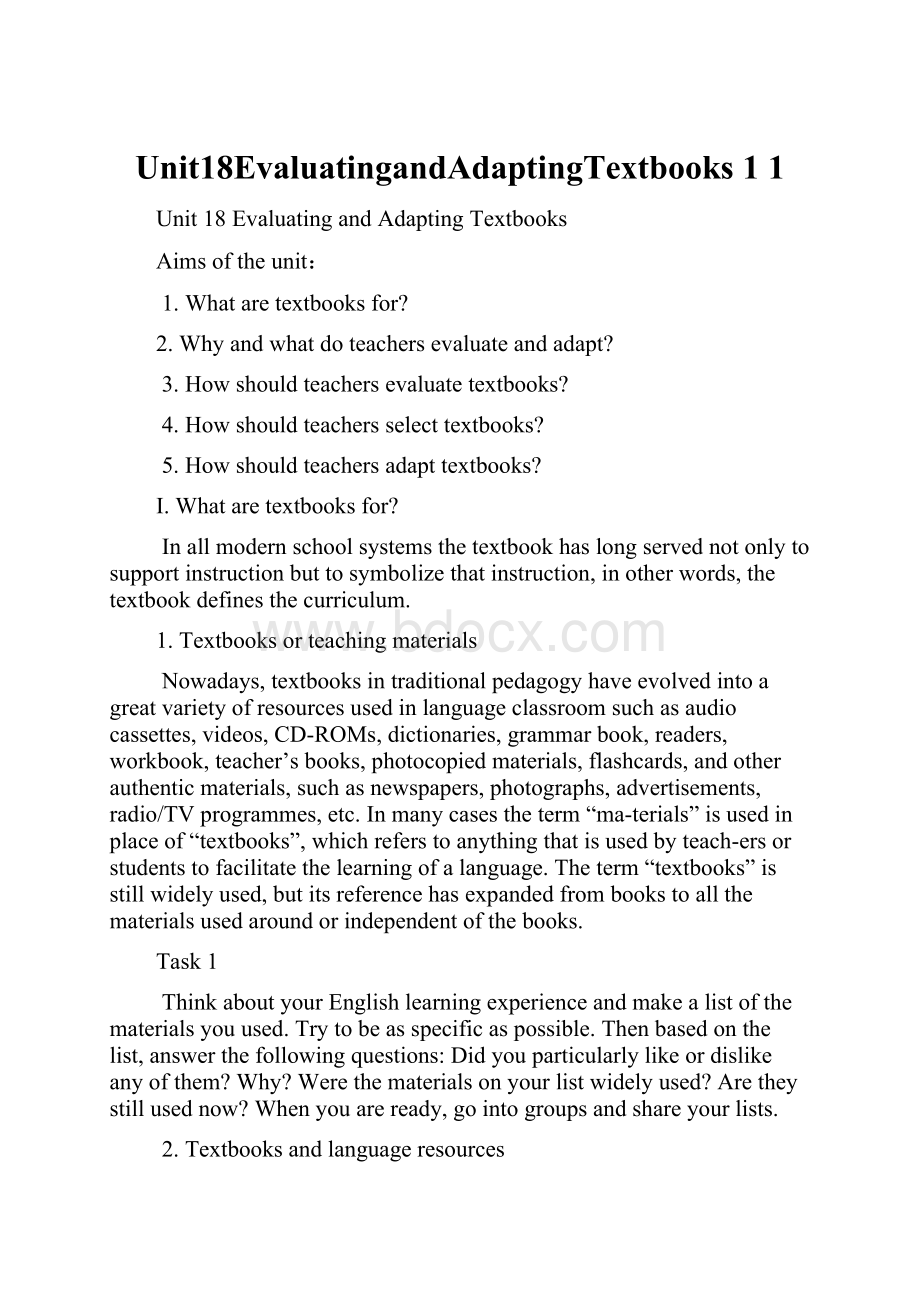Unit18EvaluatingandAdaptingTextbooks 1 1.docx
《Unit18EvaluatingandAdaptingTextbooks 1 1.docx》由会员分享,可在线阅读,更多相关《Unit18EvaluatingandAdaptingTextbooks 1 1.docx(6页珍藏版)》请在冰豆网上搜索。

Unit18EvaluatingandAdaptingTextbooks11
Unit18EvaluatingandAdaptingTextbooks
Aimsoftheunit:
1.Whataretextbooksfor?
2.Whyandwhatdoteachersevaluateandadapt?
3.Howshouldteachersevaluatetextbooks?
4.Howshouldteachersselecttextbooks?
5.Howshouldteachersadapttextbooks?
I.Whataretextbooksfor?
Inallmodernschoolsystemsthetextbookhaslongservednotonlytosupportinstructionbuttosymbolizethatinstruction,inotherwords,thetextbookdefinesthecurriculum.
1.Textbooksorteachingmaterials
Nowadays,textbooksintraditionalpedagogyhaveevolvedintoagreatvarietyofresourcesusedinlanguageclassroomsuchasaudiocassettes,videos,CD-ROMs,dictionaries,grammarbook,readers,workbook,teacher’sbooks,photocopiedmaterials,flashcards,andotherauthenticmaterials,suchasnewspapers,photographs,advertisements,radio/TVprogrammes,etc.Inmanycasestheterm“ma-terials”isusedinplaceof“textbooks”,whichreferstoanythingthatisusedbyteach-ersorstudentstofacilitatethelearningofalanguage.Theterm“textbooks”isstillwidelyused,butitsreferencehasexpandedfrombookstoallthematerialsusedaroundorindependentofthebooks.
Task1
ThinkaboutyourEnglishlearningexperienceandmakealistofthematerialsyouused.Trytobeasspecificaspossible.Thenbasedonthelist,answerthefollowingquestions:
Didyouparticularlylikeordislikeanyofthem?
Why?
Werethematerialsonyourlistwidelyused?
Aretheystillusednow?
Whenyouareready,gointogroupsandshareyourlists.
2.Textbooksandlanguageresources
II.Evaluatingtextbooks
weoftenhearteacherssay“Oh,thisisagoodtextbook”or“Well,Idon’tthinkmystudentswilllikethisbook”.Thesecommentsareusuallybasedonadhocevaluation,thatis,impressionisticevaluationbasedonintuitions,experienceofclassroomuseor‘justfirstimpression”.Contrarytoadhocevaluation,systematicevaluationoftextbooksisbasedonspecificationofobjectives,principlesandprocedures.Anidealsystematictextbookevaluationwouldbealongitudinalone,whichincludespre-useevaluation,whilst-useevaluationandpost-useevaluation.
1.On-the-pageevaluation;evaluatethetextbookitselfirrespectiveofitsusers.
2.In-the-pageevaluation:
evaluationisdonebasedontheusers’opinions(teachers’aswellaslearners’)
3.Externalevaluation:
lLookattheclaimsmadebytheauthorsofthetextbook.
lLookthroughthetableofcontentsandotherdetailsinthetextbook.
4.Internalevaluation:
lThegradingandsequencingofthematerials,naturalandappropriate?
lThelanguageinputselected,interestandlevel.
lPracticeofskillsandstrategies.
lActivitiesandtasks.Suitableornot.
lStudent-centered
Thecoreofsystematictextbookevaluationistoexaminehowwellagiventextbookmatchestheneedsofalanguageprogrammeandhoweffectivelyandefficientlyitcanrealisetheobjectivesoftheprogramme.Thereforeneedsanalysishastobedonepriortotextbookevaluation.
5.Featuresofgoodtextbooks
BasedonTomlinson’s(1998)conceptionofwhatconstituteseffectivelanguageteach-ingmaterials,webelievegoodtextbooksshouldhavethefollowingfeatures.
Goodtextbooksshould:
?
Attractthestudents’curiosity,interestandattention.
?
Helpstudentstofeelatease.
?
Helpstudentstodevelopconfidencebyprovidingtasksoractivitiesthatstudentscancopewith.
?
Meetstudents’needs.
?
Exposethestudentstolanguageinauthenticuse.
?
Providethestudentswithopportunitiestousethetargetlan-guagetoachievecommunicativepurposes.
?
Takeintoaccountthatthepositiveeffectsoflanguageteachingareusuallydelayed.
?
Takeintoaccountthatstudentsdifferinlearningstyles.
?
Maximiselearningpotentialbyencouragingintellectual,aes-theticandemotionalinvolvementwhichstimulatesbothrightandleftbrainactivi-ties.
Task2
Takeatextbookthatyouhaveusedoryouarefamiliarwith.Lookthroughthebookandseetowhatextentthebookhasreflectedthefeaturesofgoodtextbooksoutlinedabove.Whenyouareready,gointogroupsandshareyourfindings.
(providetextbooksforprimarystudentsorjuniorstudent)
III.Selectingtextbooks
Whenweevaluateatextbookwithanintentionofadoption,wetrytomatchwhatisofferedbythebookwiththeneedsofourlanguageprogramme.However,thisisnoeasyjobforteachers.Foronething,teachersmaybeoverwhelmedbytherichcontentsofthetextbook,whichusuallyhasseveralvolumes.Foranother,teachersdonotal-wayshaveaclearawarenessofwhattheirstudentsneed.Inordertomakethejoboftextbookselectioneasier,materialsresearchershavedevelopedseveralpracticalandoperationalchecklistsforclassroomteachers(SeeGrant,1987).
Lookatthequestionnairesonpage171
Choosingatextbook:
questionnaire(part1)
Choosingatextbook:
questionnaire(part2)
Choosingatextbook:
questionnaire(part3)
Task3
Choosetwosimilartextbookswhichareusedinthemiddleschoolsorcollegesintheplacewhereyouarestudying.UseGrant’squestionnaireandmakeadetailedevaluationofthetwotextbooks.Thencomparethetwotextbooksbasedontheevaluationresults.(picture)
IV.Adaptingtextbooks
Despitethegreateffortthattextbookwritersmaketomeettheneedsoftheintendedusers,textbooksaresubjecttoadaptationwhentheyareactuallyusedintheclass-room.Afterall,mostcommercialtextbooksarenotwrittenforanyparticularclass.Maley(1998:
281)suggestedthefollowingoptionstoadaptmaterials:
?
omission:
theteacherleavesoutthingsdeemedinappropriate,offensive,unpro-ductive,etc.,fortheparticulargroup.
?
addition:
wherethereseemstobeinadequatecoverage,teachersmaydecidetoaddtotextbooks,eitherintheformoftextsorexercisematerial.
?
reduction:
wheretheteachershortensanactivitytogiveitlessweightoremphasis.
?
extension:
whereanactivityislengthenedinordertogiveitanadditionaldimen-sion.(Forexample,avocabularyactivityisextendedtodrawattentiontosomesyntacticpatterning.)
?
rewriting/modification:
teachermayoccasionallydecidetorewritematerial,espe-ciallyexercisematerial,tomakeitmoreappropriate,more“communicative”,moredemanding,moreaccessibletotheirstudents,etc.
?
replacement:
textorexercisematerialwhichisconsideredinadequate,forwhat-everreason,maybereplacedbymoresuitablematerial.Thisisoftenculledfromotherresourcematerials.
?
re-ordering:
teachersmaydecidethattheorderinwhichthetextbooksarepre-sentedisnotsuitablefortheirstudents.Theycanthendecidetoplotadifferentcoursethroughthetextbooksfromtheonethewriterhaslaiddown.
?
branching:
teachersmaydecidetoaddoptionstotheexistingactivityortosuggestalternativepathwaysthroughtheactivities.(Forexample,anexperientialrouteorananalyticalroute.)
Textbookadaptationcanbedoneatthreelevels.
Thefirstlevelismacroadaptation,whichisideallydonebeforethelanguageprogrammebegins.Aftercomparingwhatiscoveredinatextbookandwhatisrequiredbythesyllabusorexamination,theteachermayfindthatcertainareasorevenwholeunitsofthebookcanbeomitted,andcertaincontentsneedtobesupplemented.
Thesecondlevelofadaptationisadaptingaunit.Thiscouldbereorderingtheactivi-ties,combiningactivities,omittingactivities,rewritingorsupplementingexercisema-terial,etc.
Thethirdlevelisadaptationofspecificactivitiesinaunit.Occasionallyanactivityisregardedasvaluable,butitisnotwell-designedoritisnotfeasibleinaparticularclass.Iftheteacherdoesnotwanttogiveuptheactivity,heorsheneedstoadaptit.
Veryoften,adaptationinvolvessupplementation,thatis,teachersaddmaterialsfromotherresourcestothetextbooktheyareusing.Itisbelievedthatauthenticmaterialsarebetterthannon-authenticmaterialsforsupplementation.Soteacherswhomakeapointofcollectingauthenticmaterialsfinditmucheasiertoadapttextbooks.ThisisespeciallytrueinELTcontextswhereauthenticEnglishmaterialsarenotalwaysreadilytohand.
Task4
Chooseatextbookthatyouarefamiliarwith.Imagineyouaregoingtousethebookwithaclassinyourlocality.Findaunitthatyouthinkneedsadaptationandadaptit.
V.Conclusion
Inthisunitwehavebrieflytalkedabouttextbookevaluation,selectionandadaptation.
Thevalueoftheseactionsissoobviousthatnoonewouldargueagainstit.However,theseactionscanbedoneonlywhenthreeconditionsaremet.
Firstly,teachersneedtohavetheauthoritytoevaluate,selectandadapttextbooks.Inmanycases,teachersaresimplytoldtouseacertaintextbook.Inworsecircumstances,teachersaretoldhowtouseabook.Someteachersareevencriticizedforintentionallyleavingoutactivitiesthattheydonotconsiderappropriateornecessary.
Secondly,teachershavetohavetheinitiativetoevaluate,selectandadapttextbooks.Veryoften,withaheavyworkload,teacherssimplydonothavethetimeorenergytodoanythingbeyondlessonplanningandmarkingstudents’homework.Withoutex-plicitencouragementfromauthorities,manyteachersdonotmakeanefforttoevalu-ateandadapttextbooks.
Thirdly,teachersneedtoknowhowtoevaluate,selectandadapttextbooks.Atthetimewhenthisbookisbeingwritten,veryfewELTteachereducationprogrammesinChinaofferspecifictraininginmaterialsevaluationanddesign,andpublicationsonELTmaterialsarehardtofind.Iftextbookevaluationiseverdone,itismostlyadhocimpressionisticjudgementbasedonexperienceorintuition.Iti